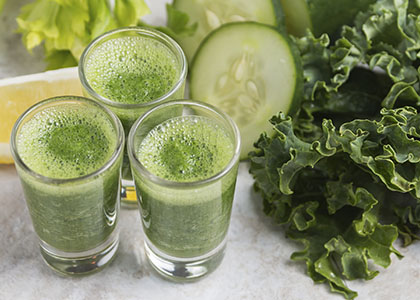
Why the Mean Green is So Good for You
By Stacy Kennedy, MPH, RD, CSO, LDN; Reboot Nutritionist
The now famed Mean Green Juice has become a household staple in kitchens across the globe. If you have a juicer, you can make the Mean Green for a quick, healthy dose of phytonutrients that are sure to energize and nourish you. It’s the drink you see Joe enjoy throughout Fat, Sick & Nearly Dead, and is one of the most popular juice choices in the Reboot community.
We all know the Mean Green is good for you because, well, it’s green, but ever wondered exactly why? We break down the nutrition science for you here starting off with these 6 key ingredients that make this juice so healthful and delicious.
1. Cucumber:
Cukes are well known for helping reduce inflammation when applied directly to the skin but they can work all sorts of wonders inside the body too. Cucumbers contain phytosterols, shown to help lower cholesterol levels, as well as electrolytes like potassium important for keeping blood pressure in check. They’re also super hydrating thanks to their high water content.
2. Celery:
Hate this veggie’s stringy texture but want all the goodness locked away inside? Well, juice it! Celery is rich in natural sodium making it an important part of a juicing plan or workout related drink for a healthy dose of electrolytes. Celery also contains carotenoids like lutein which promote eye health especially with age and may help reduce risk of developing certain cancers.
3. Apples:
The old adage an apple a day still rings true. Research supports consuming apples to help reduce the risk of certain types of cancers, like colon cancer, thanks in part to their antioxidants, including quercitin. These same powerhouse nutrients and high soluble fiber content (yes that’s the kind of fiber that is in your juice!), can also help reduce cholesterol levels.
4. Kale:
These days K is for Kale. It’s a fantastic source of calcium, iron, copper, manganese, phosphorus, potassium and vitamins A and C. Kale is low calorie and yet incredibly dense with nutrients. Kale also boasts compounds that promote eye and skin health, like lutein. It’s generally better to get your lutein from eating or juicing kale than supplements.
5. Lemon: Looking for a vitamin-C packed, natural anti-nausea, metabolism and immune supporting addition to your favorite juice? Lemons are where it’s at! Did you know that even smelling a fresh lemon may help calm a queasy stomach? For a less bitter taste in juice, peel your lemons first. And don’t forget to add it to warm water for a morning ritual that starts your day on the right foot.
6. Ginger:
Long touted for its natural digestive aid qualities, ginger has become a staple for those looking to support their immune system, reduce inflammation or ease an angry tummy.
Get Joe’s Mean Green recipe here
The specific combinations of fruits and veggies in this juice have helpful synergy. For example, consuming a vitamin C rich food like apple and lemon at the same time as a plant-based iron source, like kale, can help our body absorb more of the iron.
Beyond the specific benefits of the vitamins, minerals and phytonutrients locked away in each ingredient, the act of juicing them may have additional advantages for certain individuals.
A recent study found that men who drank fresh vegetable juice with ingredients like kale, compared to commercial vegetable juice, had significantly lower total and LDL (bad) cholesterol levels after just 4 weeks.
Juicing may also help to enhance the body’s ability to absorb certain nutrients often bound up by insoluble fibers. While eating of course remains a vital way of consuming nutrients including the insoluble fibers important for hunger control and blood sugar management, juicing can be a healthy addition to any plant-based diet. For those with bowel concerns making eating salads or a big bowl of the Mean Green veggies in their raw form a challenge, juicing offers an option to ingest these vital nutrients.
Juice On!